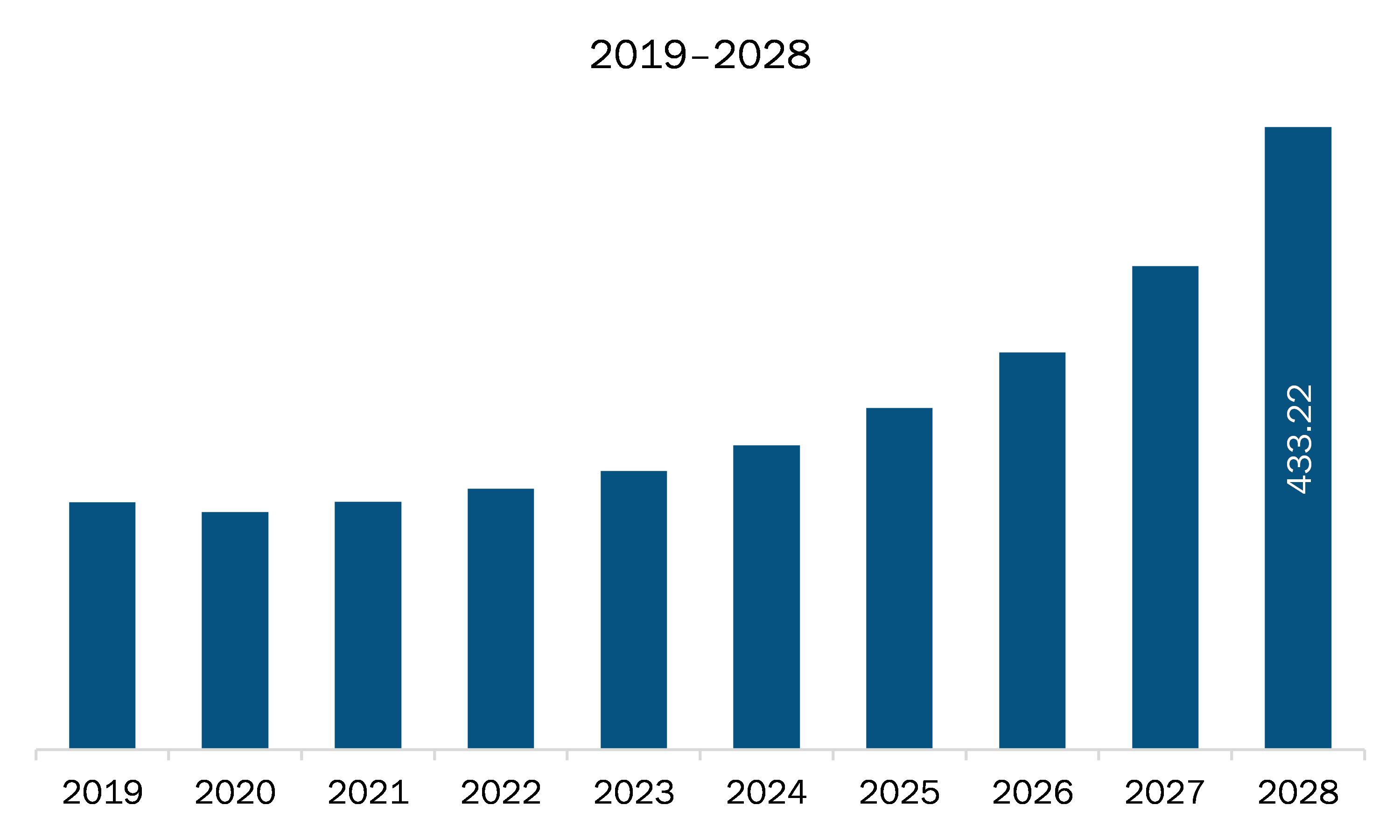The drone simulator market in Europe is projected to reach US$ 433.22 million by 2028 from US$ 172.62 million in 2021; it is estimated to grow at a CAGR of 14.0% from 2021 to 2028.
France, Germany, Italy, UK, and Russia are major economies in Europe. Research and development witnessing investment rise for military simulation is the major factor driving the growth of the Europe drone simulator market. Governments across Europe are cutting military spending due to the dwindling financial resources owing to the COVID-19 outbreak. Many nations' military ministries are cutting training expenditures and downscaling their forces. As a result, the military's attention has shifted toward finding less expensive and more effective solutions to their needs. Real-time training is time-consuming and costly. Also, it necessitates a huge quantity of raw resources, such as gasoline and explosives, and consists of a high level of danger. Therefore, military ministries are increasingly preferring virtual training and simulation-based games that use technologies, such as big data, AI, and cloud computing. Military simulation and virtual training are becoming increasingly popular among military forces across the world because they are based on commercial-off-the-shelf (COTS) components, and they help minimize training expenses. The simulators are made at a minimal cost of development. The criteria are critical for the military to innovate massively in simulation-based training technology. Drone simulations are currently being used to train future soldiers and represent a real-time scenario using realistic digital settings. Hence, increased expenditures in simulation software drive the growth of the drone simulator market. In addition, several nations' defense ministries are restructuring and changing their militaries using new solutions, which is also bolstering the market growth.
In Europe, the COVID-19 pandemic has a different impact on different countries, as only selective countries have witnessed the rise in the number of cases and subsequently attracted strict, as well as prolonged, lockdown periods or social isolation norms. However, Western European countries such as Germany, France, Russia, and the UK have seen a comparatively modest decrease in their growth activities because of their strong healthcare systems. These countries have been investing significantly to make the diagnosis and treatment of the disease more effective and less time-consuming. According to the Centre for Strategic and International Studies (CSIS), military spending in in European countries is likely to decrease amid the global financial crisis caused by COVID-19. According to CSIS, France, the UK, and Germany pay for a substantial portion of Europe's overall military budget, and these countries are likely to bring down their military budget allocations in 2021 due to macroeconomic situations. For instance, Germany has proposed a cut in defense spending from US$ 20.3 billion in 2020 to US$ 18.7 billion in 2024, which is likely to stymie military modernization and other armament programs. As a result, the drone simulator industry in Europe is likely to struggle in the coming years.
With the new features and technologies, vendors can attract new customers and expand their footprints in emerging markets. This factor is likely to drive the Europe drone simulator market. The Europe drone simulator market is expected to grow at a good CAGR during the forecast period.

- This FREE sample will include data analysis, ranging from market trends to estimates and forecasts.
Europe Drone Simulator Market Segmentation
Europe Drone Simulator Market – By Component
- Hardware
- Software
Europe Drone Simulator Market – By Simulator Type
- Fixed
- Portable
Europe Drone Simulator Market – By Drone Type
- Fixed Wing
- Rotary Wing
Europe Drone Simulator Market – By Technology
- Augmented Reality
- Virtual Reality
Europe Drone Simulator Market, by Country
- France
- Germany
- Italy
- UK
- Russia
- Rest of Europe
Europe Drone Simulator Market - Companies Mentioned
- CAE Inc.
- HAVELSAN A.S.
- Israel Aerospace Industries Ltd.
- L3Harris Technologies, Inc.
- Leonardo S.p.A.
- SINGAPORE TECHNOLOGIES ELECTRONICS LIMITED
Europe Drone Simulator Report Scope
| Report Attribute | Details |
|---|---|
| Market size in 2021 | US$ 172.62 Million |
| Market Size by 2028 | US$ 433.22 Million |
| CAGR (2021 - 2028) | 14.0% |
| Historical Data | 2019-2020 |
| Forecast period | 2022-2028 |
| Segments Covered |
By Component
|
| Regions and Countries Covered |
Europe
|
| Market leaders and key company profiles |
|
- Historical Analysis (2 Years), Base Year, Forecast (7 Years) with CAGR
- PEST and SWOT Analysis
- Market Size Value / Volume - Regional, Country
- Industry and Competitive Landscape
- Excel Dataset
Recent Reports
Testimonials
Reason to Buy
- Informed Decision-Making
- Understanding Market Dynamics
- Competitive Analysis
- Identifying Emerging Markets
- Customer Insights
- Market Forecasts
- Risk Mitigation
- Boosting Operational Efficiency
- Strategic Planning
- Investment Justification
- Tracking Industry Innovations
- Aligning with Regulatory Trends






















 Get Free Sample For
Get Free Sample For